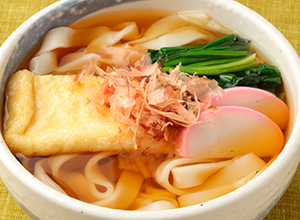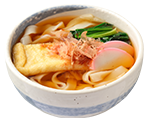5
Kishimen Noodles
- Characteristics
- Arrangement
- Noodle Characteristics
A type of broad, flat Udon-like noodle which originated in the Edo Period (1603-1868).

Dry kishimen noodles are defined by JAS (Japan Agricultural Standards) as being more than 4.5mm wide, and less than 2mm thick. The soup is tamari soy sauce based, with dried Soda-bonito and mackerel stock. Basic ingredients include deep fried tofu, steamed fish paste, green leaf vegetables, and dried bonito shavings to name a few.
Various theories exist as to whether it was named for having featured pheasant meat (kiji), or having originated in the Kishu region, after Japanese chess pieces (kiji) or even came from Himokawa Udon in Imagawa, Kariya City. During the construction of Nagoya Castle, thin noodles were made in order to prepare them quickly for the workers, proof they have been eaten since the Edo period.
Found mainly in Nagoya and surrounding areas, and rarely in other regions. Dried noodles for home use are common. A few udon specialty shops can be found in the Mikawa (east Aichi) area.

Kishimen’s unique soup flavor and noodle texture makes an exquisite combination. Prepared in the time honored Nagoya style.